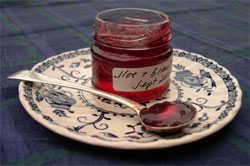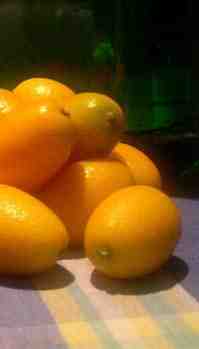Sloe and Bramley Apple Jelly Recipe
Posted by Fiona Nevile in Jam Jelly and Preserves | 110 comments
Tiny pot of sloe and apple jelly
This recipe makes a good raunchy jelly to eat with red meat, game and strong cheese. It’s also great as a sauce base for red meat, such as lamb chops. Danny usually adds a generous dollop to his pheasant casserole and dinky individual game pies, rather than adding a slug of port or sloe gin. As Sloe and Bramley Jelly has a good, strong depth of flavour it is definitely worth making a decent batch for your store cupboard. We use a bit more sugar than the usual 1pt/1lb ratio with this jelly and this seems to work well as we always use cooking apples.
Ingredients:
- 1 1/2 pounds/700g sloes, washed
- 1 1/2 pounds/700g of bramley cooking apples (ideal) or any other cooking apples. We use windfalls as they won’t keep.
- Sugar (1 UK pint/750ml/2 1/2 cups of strained juice to 1 1/2 pounds/700g of white granulated sugar, if using cooking apples. 1 pint/750ml/2 1/2 cups of strained juice to 1 pound/454g if using sweet eating apples).
Method:
- Wash the apples, cut out bad bits and chop roughly. There is no need to peel or core the apples.
Place sloes and apples in a large deep heavy bottomed saucepan, or preserving pan. - Add water to cover ½ of the fruit. Bring slowly to the boil and simmer very gently until all the fruit is soft and squishy. (This can take anything from 20 minutes to an hour, depending on how ripe the fruit is.)
- Pour the cooked fruit through sterilised muslin (how do I sterilise muslin? See tips and tricks below). The muslin is often referred to as a “jelly bag”. We use tall buckets to catch the drips from the jelly bags. Rather than hang the bags (conventional method-between two stools) I find it easier to line a large plastic sieve with the muslin. This clips neatly onto the top of a clean bucket. The sieve is covered with a clean tea cloth to protect against flies.
- Leave the jelly bag to drip overnight (or about 12 hours).
- Measure the juice the next day.
- Pour the juice into a deep heavy bottomed saucepan and add 1½ lb/700g of white granulated sugar for each 1pt/570ml of juice.
Heat the juice and sugar gently stirring from time to time, so as to make sure that that all the sugar has dissolved before bringing the liquid slowly to the boil. - Continue to boil for about 10 minutes before testing for a set. This is called a rolling boil. (What is testing for a set? See tips and tricks below).
- Tossing in a nugget of butter towards the end will reduce the frothing that can occur.
When jelly has reached setting point pour into warm sterilised jars using a funnel and ladle. (How do I sterilise jars? See tips and tricks below). - Cover immediately with plastic lined screw top lids or waxed disks and cellophane tops secured with a rubber band.
- Label when cold and store in a cool, dark place. Away from damp.
Tips and tricks:
- What is a jelly bag?
A jelly bag is traditionally a piece of muslin but it can be cheesecloth, an old thin tea cloth or even a pillowcase. The piece needs to be about 18 inches square. When your fruit is cooked and ready to be put in the jelly bag, lay your cloth over a large bowl. Pour the fruit into the centre of the cloth and tie the four corners together so that they can be slung on a stick to drip over the bowl. Traditionally a stool is turned upside down, the stick is rested on the wood between the legs and the jelly bag hangs over the bowl. We experimented and now line a sieve with muslin, place it over a bucket and cover the lot with clean tea cloths (against the flies). - How do I sterilise muslin/the jelly bag?
Iron the clean jelly bag with a hot iron. This method will also sterilise tea cloths. - Jam “set” or “setting point”?
Getting the right set can be tricky. I have tried using a jam thermometer but find it easier to use the following method.
Before you start to make the jam, put a couple of plates in the fridge so that the warm jam can be drizzled onto a cold plate (when we make jam we often forget to return the plate to the fridge between tests, using two plates means that you have a spare cold plate). Return the plate to the fridge to cool for approx two minutes. It has set when you run your finger through it and leave a crinkly track mark. If after two minutes the cooled jam is too liquid, continue to boil the jam, testing it every few minutes until you have the right set. The jam is far more delicious if it is slightly runny. - How do I sterilise the jars?
We collect jars all year round for our jelly, chutney and jam making sessions. I try to soak off labels and store the clean jars and metal plastic coated screw-top lids in an accessible place. The sterilising method that we use is simple. Just before making the jam, I quickly wash and rinse the jars and place them upside down in a cold oven. Set the temperature to 160c/140c for fan assisted. When the oven has reached the right temperature I turn off the heat. The jars will stay warm for quite a while. I only use plastic lined lids for preserves as the all-metal lids can go rusty. I boil these for five minutes in water to sterilise them. If I use Le Parfait jars, I do the same with the rubber rings.
Leave a reply







Thanks for all that Steve. I did use the sloes from my gin (had read on this site somewhere that you can recycle the gin soaked sloes). I think maybe I didn’t lower the heat enough either. My sloes would squish but only with a fair amount of pressure on them. The jelly I made has set but has no real taste, just sweet really. I hate the thought of wasting all those boozy sloes but this definately wasn’t a success! Maybe I will give it a go again using half the suggested fruit amount (save waste if I am not successful again). Please would you tell me how much water you add?
Many thanks for the advice,
Amanda
Hi
It sounds as though you have re-used sloes AFTER making sloe gin. That’s not the way, although would account for the pale colour. The sloes for the jelly must be fresh. In addition, there should be no need to top up the water as it evaporates because it shouldn’t SIMMER (no need to boil the guts out of it)for longer than an hour for the fruit softening part, although in practice I have always found about 1/2 an hour is enough. I also give the fruit a good stir AND have even taken the masher to it to get as much as possible from it. It doesn’t matter how much you bash the fruit around whilst it is cooking as it’s going to be strained anyway.
Once the fruit has been strained and the sugar then added to the juice, the resultant mixture should be roll-boiled without further additions of water, although as I have said, I have added a glug of port to mine which helps to bring out the other flavours. Again, this should take too long (if you ue jam sugar with the added pectin) – 20 mins or so before setting occurs.
Sorry, but I think you’re missing something but without popping over (wherever you are) to do it with you, it’s difficult to know how else to help.
Hi all,
My attempt at sloe and bramley jelly using gin sloes is a disaster! Where do I start?!
Its a sort of dusky pink colour rather than red, has tiny bubbles right through it (only had margarine and not sure if that works with froth clearing the same as butter so I didn’t use it) and I have produced less than half a jam jar full!
The apples simmered until they were virtually pureed but the sloes didn’t squidge down at all. I wonder if the colour from the sloes all went into the gin hence the pale jelly? I also squeezed the pulp (should have read all the past comments first). I have a large jam pan and added water to cover half the fruit as stated, then topped it up as it evaporated.
Does anyone please have any tips? Or should I accept the fact that I am not a natural jam/jelly producer!
I’ve made 3 batches of this jelly so far and it’s absolutely delicious. I have tended to use jam sugar (with added pectin) and a glug of port each time with wonderful results. In addition, I have used kilner jars and screw tops (with neither celophane or waxed discs). One added tip – strain through a square of muslin and a sieve; once the bulk of the juice has strained through, tie 2 corners together, making a sort of sling, then feed the handles of 2 wooden spoons through each hole created by the ties. Twist in opposite directions like a tourniquet and wring out more juice. More effective than waiting in terms of both time and quantity. Enjoy!
Just getting things together to make this jelly and was wondering how much the recipe makes, i.e. how many jam jars do i need, I mainly have 8oz jars (225g). Hope someone can help.
I came on to ask whether I should worry that the liquid currently straining is opaque, but I have found the answer above – hopefully it will sort itself out tomorrow then.
Hi Sara
I’ve an article here that will help you
https://www.cottagesmallholder.com/jelly-set-too-hard-514
Just made first ever batch of sloe and bramley jelly. absolutely lovely. thanks cottage smallholder for fantastic site.
question: i think i’ve boiled it too far and now its very sticky and thick. could i reheat it and add a bit more fluid to make it more jelly like?
any suggestions?
Hi Sharon
I don’t really know the ins and outs of using waxed disks. I use them for jam – with cellophane lids but not for jelly whether using cellophane or proper lids.
I’ve never put jam in a kilner jar but if I did I wouldn’t use waxed disks. I’m sure that you can find out on the internet if there’s a proper way of using/not using them.
Hi – it worked, clear and jewel like jelly all potted up (and now I think I am addicted to making jelly, second lot, apple and rosemary, currently on the go).
Another question though – do I use wax discs as I would with jam – am using re-cyled jars with lids? Also, when making jam, do I need to use waxed discs if potting up into kilner jars?
Sharon